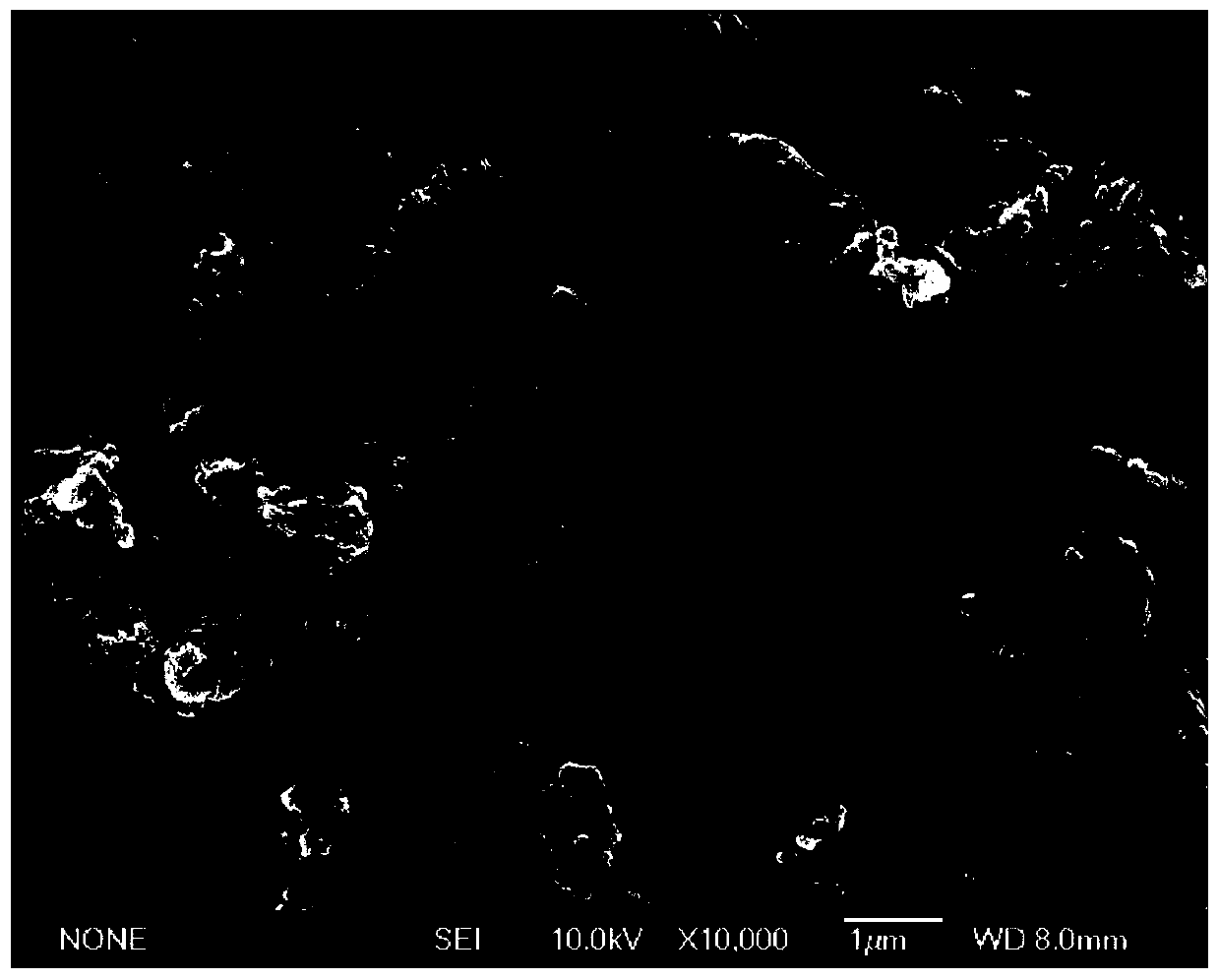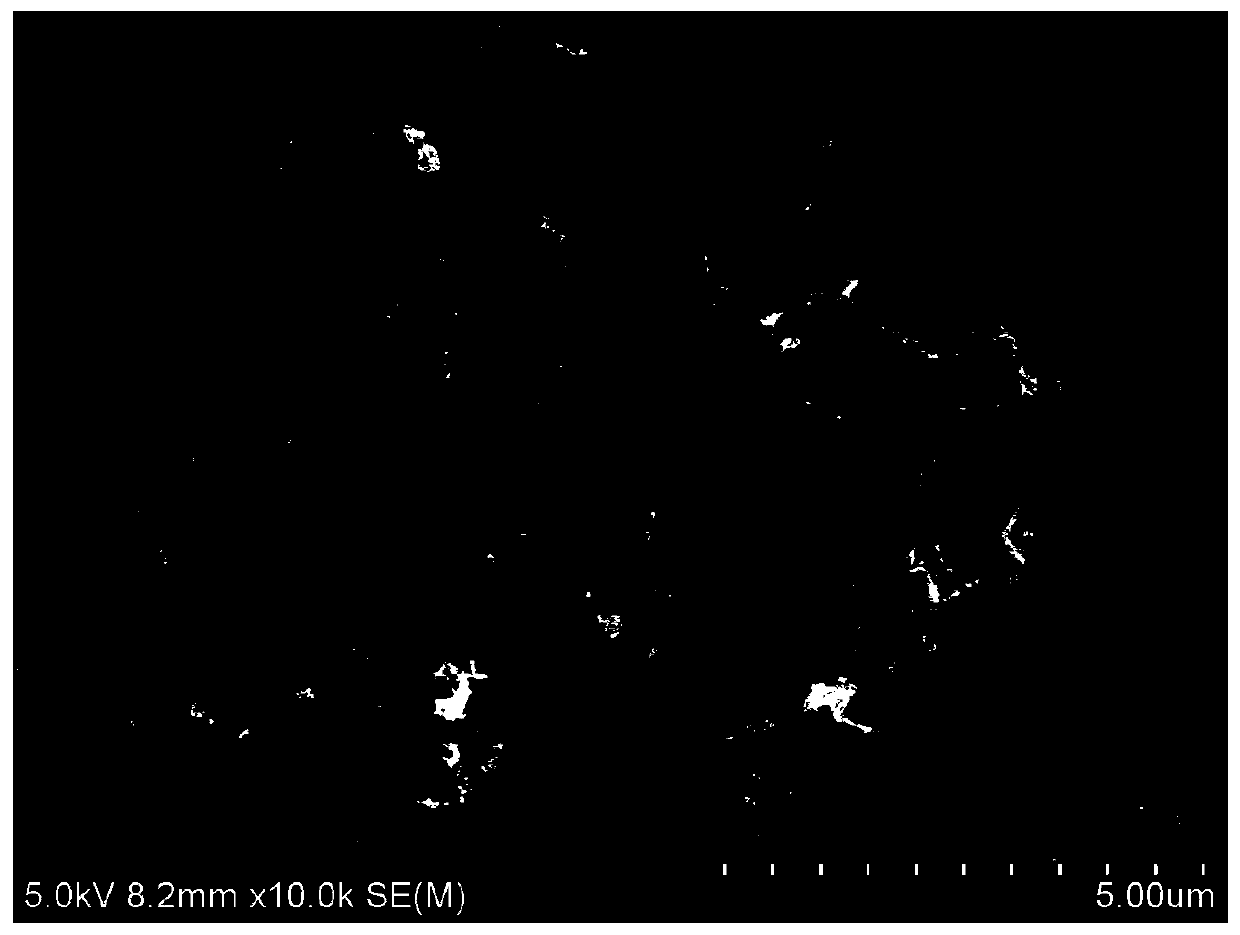Silicon-carbon negative electrode material and preparation method thereof
A negative electrode material, silicon carbon technology, applied in the field of silicon carbon negative electrode materials and its preparation, can solve the problems of unfavorable preparation, high cost, and inability to effectively solve silicon volume changes, etc., achieve excellent industrialization prospects, prolong cycle life, and improve cycle stability sexual effect
- Summary
- Abstract
- Description
- Claims
- Application Information
AI Technical Summary
Problems solved by technology
Method used
Image
Examples
Embodiment 1
[0040] (1) Preparation of polymer coating layer: take 8.00 grams of elemental silicon powder (average particle size 1 micron), add 100 grams of 10% dilute hydrochloric acid, add 1.10 grams of catechol, 0.55 grams of hydroquinone and 2.43 grams of 37% formaldehyde solution, stirred at 100°C for 1 hour, filtered, washed with water, and dried to obtain a polymer nanobelt-coated silicon material;
[0041] (2) Carbonization treatment: transfer the above-mentioned polymer nanobelt-coated silicon material into a furnace protected by an inert atmosphere, and raise the temperature to 800° C. for 6 hours at a heating rate of 10° C. per minute to obtain a silicon-carbon negative electrode material;
[0042] (3) Electrochemical performance test: Prepare the above-mentioned silicon carbon negative electrode material, acetylene black and LA133 binder according to the ratio of 80:10:10 into a uniform slurry, and apply the above-mentioned slurry on the copper foil, dry , and assembled into a ...
Embodiment 2
[0044] (1) Preparation of polymer coating layer: take 18.00 grams of porous silicon powder (average particle size 3 microns, specific surface area 120m 2 / g), add 100 grams of 10% dilute hydrochloric acid, add 1.65 grams of catechol and 2.43 grams of 37% formaldehyde solution, filter after stirring for 6h at 50°C, wash with water, and dry to obtain polymer nanobelt-coated silicon Material;
[0045] (2) Carbonization treatment: transfer the above-mentioned polymer nanobelt-coated silicon material into a furnace protected by an inert atmosphere, and raise the temperature to 850° C. for 2 hours at a heating rate of 10° C. per minute to obtain a silicon-carbon negative electrode material;
[0046] (3) Electrochemical performance test: The above-mentioned low-expansion silicon-carbon composite negative electrode material, acetylene black and LA133 binder were prepared into a uniform slurry according to the ratio of 80:10:10, and the above-mentioned slurry was coated on the copper f...
Embodiment 3
[0048] (1) Preparation of polymer coating: get 2.00 grams of nano-silicon powder (average particle diameter 100nm), add 100 grams of 10% dilute hydrochloric acid, add 1.65 grams of catechol and 2.43 grams of 37% formaldehyde solution, 50 ° C After stirring for 6 hours, filter, wash with water, and dry to obtain a polymer nanobelt-coated silicon material;
[0049] (2) Carbonization treatment: transfer the above-mentioned polymer nanobelt-coated silicon material into a furnace protected by an inert atmosphere, and raise the temperature to 900° C. for 2 hours at a heating rate of 10° C. per minute to obtain a silicon-carbon negative electrode material;
[0050] (3) Electrochemical performance test: Prepare the above-mentioned silicon carbon negative electrode material, acetylene black and LA133 binder according to the ratio of 80:10:10 into a uniform slurry, and apply the above-mentioned slurry on the copper foil, dry , and assembled into a button battery after being punched, the...
PUM
 Login to View More
Login to View More Abstract
Description
Claims
Application Information
 Login to View More
Login to View More - R&D Engineer
- R&D Manager
- IP Professional
- Industry Leading Data Capabilities
- Powerful AI technology
- Patent DNA Extraction
Browse by: Latest US Patents, China's latest patents, Technical Efficacy Thesaurus, Application Domain, Technology Topic, Popular Technical Reports.
© 2024 PatSnap. All rights reserved.Legal|Privacy policy|Modern Slavery Act Transparency Statement|Sitemap|About US| Contact US: help@patsnap.com










